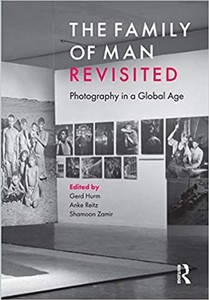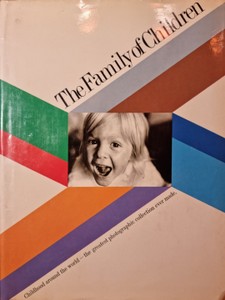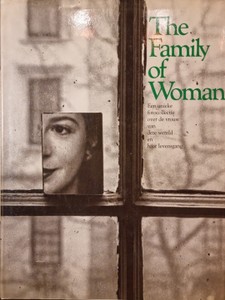Fotohistorie: The Family Of Man
Gepubliceerd door Jan Mendrik · 27 augustus 2021
Fotoboeken van tentoonstellingen of talentvolle fotografen zijn een bron van inspiratie. Van voorbeelden van beroemde fotografen is veel te leren. Erik Kim heeft veel leerzaams geschreven over wat hij leerde van de grote fotografen.
Bronnen van boeken van belangrijke tentoonstellingen, wedstrijden of fotografen zelf zijn: de boekhandel of museum bookshops (vaak prijzig) maar vaak kan je ook mooie boeken vinden bij tweedehands boekwinkels of kringloopwinkels.
Zo kocht ik onlangs bij Vinbooks Vlamingstraat 14 in Delft een origineel (?) exemplaar van de tentoonstelling The Family of Man in het Museum of Modern Art in New York in 1955. Herdrukken zijn tot op vandaag gewoon te koop in de boekwinkel en de tentoonstelling was zo iconisch voor de fotografie dat zij in haar geheel permanent te bekijken is in kasteel van Clervaux in Luxemburg. De tentoonstelling is ook opgenomen in het register van het wereldgeheugen van de UNESCO.
Wat was er zo bijzonder aan die tentoonstelling? Edward Steichen zelf een van de grootste Amerikaanse fotografen stelde de tentoonstelling samen. Hij koos 503 foto’s uit een totaal van zo’n 2 miljoen bekeken foto’s.
Voor Nederland waren de volgende fotografen opgenomen: Emmy Andriesse, Eva Besnyö, Ed van der Elsken, Henk Jonker, Cas Oorthuys en Nico Jesse
Edward Steichen geloofde dat fotografie de mens iets kon leren over zichzelf: "I am no longer concerned with photography as an art form. I believe it is potentially the best medium for explaining man to himself and his fellow man".
De tentoonstelling was een statement voor eenheid van mensen en volkeren en tegen oorlog.
De tentoonstelling was een statement voor eenheid van mensen en volkeren en tegen oorlog.


n 2017 verscheen nog The Family of Man Revisited, een filosofische beschouwing achteraf over de tentoonstelling.
Met o.a. beschouwingen door Max Horkheimer (filosoof van de Frankfurter Schule).
In haar boek "on photography" keek Susan Sontag terug op The Family of Man. Ze benadrukte dat de manier van kijken heel specifiek was voor die tijd. Ze deed dat door een vergelijk te maken met een expositie van foto's van Diane Arbus in 1972.
Five hundred and three photographs by two hundred and seventy-three photographers from sixty-eight countries were supposed to converge—to prove that humanity is “one” and that human beings, for all their flaws and villainies, are attractive creatures. The people in the photographs were of all races, ages, classes, physical types. Many of them had exceptionally beautiful bodies; some had beautiful faces. As Whitman urged the readers of his poems to identify with him and with America, Steichen set up the show to make it possible for each viewer to identify with a great many of the people depicted and, potentially, with the subject of every photograph: citizens of World Photography all.It was not until seventeen years later that photography again attracted such crowds at the Museum of Modern Art: for the retrospective given Diane Arbus’s work in 1972. In the Arbus show, a hundred and twelve photographs all taken by one person and all similar—that is, everyone in them looks (in some sense) the same—imposed a feeling exactly contrary to the reassuring warmth of Steichen’s material. Instead of people whose appearance pleases, representative folk doing their human thing, the Arbus show lined up assorted monsters and borderline cases—most of them ugly; wearing grotesque or unflattering clothing; in dismal or barren surroundings—who have paused to pose and, often, to gaze frankly, confidentially at the viewer.Arbus’s work does not invite viewers to identify with the pariahs and miserable-looking people she photographed. Humanity is not "one."The Arbus photographs convey the anti-humanist message which people of good will in the 1970s are eager to be troubled by, just as they wished, in the 1950s, to be consoled and distracted by a sentimental humanism. There is not as much difference between these messages as one might suppose. The Steichen show was an up and the Arbus show was a down, but either experience serves equally well to rule out a historical understanding of reality.
In een kringloopboekwinkel in Wageningen kocht ik "The family of children" (1977 en "The family of woman" (1979) die geheel op het origineel van "The family of man" zijn gebaseerd.


Soms kan je op internet elektronische versies van "The Family of Man" gratis vinden. Zoals hier en de "Family of Man revisited" hier.
1
beoordeling
Jan Mendrik
20 okt 2021
Dit is een test om te zien of het goed overkomt

